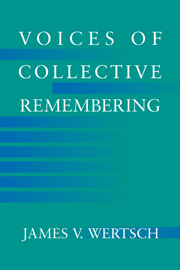Book contents
- Frontmatter
- Contents
- Introduction and Acknowledgments
- 1 An Encounter with Collective Memory
- 2 Methodological Preliminaries to the Study of Collective Remembering
- 3 Collective Memory: A Term in Search of a Meaning
- 4 State Production of Official Historical Narratives
- 5 Narrative Dialogicality and Narrative Templates in the Production of Official Collective Memory
- 6 The Consumption of Historical Narratives
- 7 Generational Differences in Collective Remembering
- Conclusion
- References
- Index
Introduction and Acknowledgments
Published online by Cambridge University Press: 08 January 2010
- Frontmatter
- Contents
- Introduction and Acknowledgments
- 1 An Encounter with Collective Memory
- 2 Methodological Preliminaries to the Study of Collective Remembering
- 3 Collective Memory: A Term in Search of a Meaning
- 4 State Production of Official Historical Narratives
- 5 Narrative Dialogicality and Narrative Templates in the Production of Official Collective Memory
- 6 The Consumption of Historical Narratives
- 7 Generational Differences in Collective Remembering
- Conclusion
- References
- Index
Summary
In this book, I take up three main tasks. First, I outline the meaning (rather meanings) of “collective memory.” Because this term has almost as many interpretations as interpreters, I devote considerable attention to it, especially in Chapter 3. Second, in parts of Chapters 1, 2, and 3, I outline a particular approach to collective memory, one that focuses on how “cultural tools,” especially narrative texts, mediate its functioning. From this perspective, collective memory is best understood as being “distributed” between active agents and the textual resources they employ. This amounts to narrowing the field of memory studies, but it remains an effort to harness ideas from a wide range of intellectual traditions. And third, in Chapters 4 through 7, I have sought to put these ideas to work in connection with a body of empirical evidence from Soviet and post-Soviet Russia. As will become clear, this is often not so much a matter of putting wellformulated ideas into practice as it is one of clarifying these ideas in the first place.
The general plan of the volume, then, starts out broadly and converges on a narrower set of concerns. It begins by opening up several issues that could, and eventually should, be addressed under the heading of collective memory, moves to outlining a particular way to proceed, and then to harnessing this particular approach to look at empirical examples. Any one of these topics could have taken up an entire book in its own right – and each almost did in various incarnations of this one. However, I have tried to weave them into a single discussion because I view the analysis of each as informing the others.
Information
- Type
- Chapter
- Information
- Voices of Collective Remembering , pp. 1 - 3Publisher: Cambridge University PressPrint publication year: 2002
